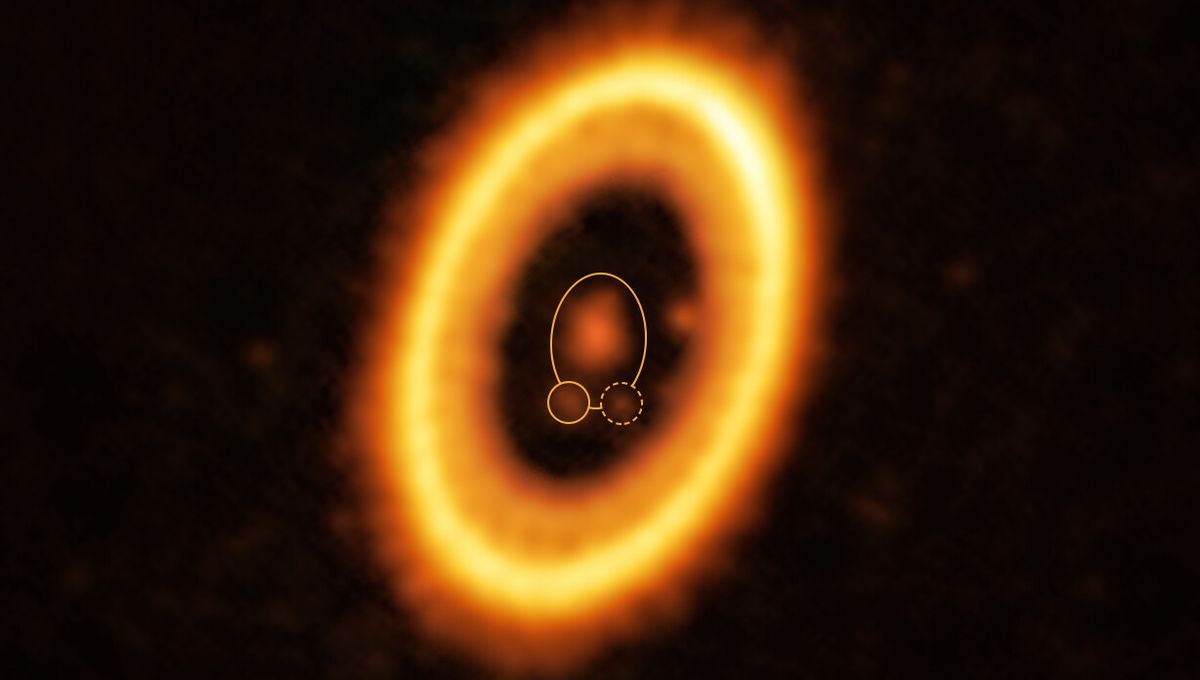
Conspiracy theories old and new have fantasized about a planet on the opposite side of the Sun sharing the same orbit with Earth. While that is nonsense, orbital mechanics allows for multiple celestial bodies to share the same orbit on specific conditions. The Trojan asteroids around Jupiter and Earth are prime examples. Now, astronomers have found the first example in another solar system.
The PDS 70 star system is very young and we know it has two planets for certain, PDS 70b and PDS 70c. Located 400 light-years away, the planets are both believed to be gas giants like Jupiter. On the same orbit of PDS 70b, astronomers have discovered a large cloud of debris, a possible indication of a forming planet or the leftovers of a planet already formed.
“Two decades ago it was predicted in theory that pairs of planets of similar mass may share the same orbit around their star, the so-called Trojan or co-orbital planets. For the first time, we have found evidence in favour of that idea,” lead author Olga Balsalobre-Ruza, a student at the Centre for Astrobiology in Madrid, said in a statement.
Trojan asteroids are rocky bodies in the same orbit as a planet. Jupiter has over 4,800 split into two groups, one preceding the gas giant and the other following, while Earth has two confirmed. Jupiter’s sit at L4 and L5, 60 degrees ahead and behind the planet in the same orbit. The cloud of debris in the PDS 70 system is also on one of these Trojan zones, and astronomers believe they are observing some sort of exotrojan situation with an object twice the size of the Moon forming in this orbital configuration.
“Exotrojans [Trojan planets outside the Solar System] have so far been like unicorns: they are allowed to exist by theory but no one has ever detected them,” added co-author Jorge Lillo-Box, a senior researcher at the Centre for Astrobiology.
In the case of this system, the masses of the two potential objects are wildly different and the orbit is roughly how far Uranus is from the Sun. But it is possible that smaller planets orbiting closer to their stars exist, opening a whole new range of possibilities on what kind of worlds (and maybe life forms) could exist there.
“Who could imagine two worlds that share the duration of the year and the habitability conditions? Our work is the first evidence that this kind of world could exist,” explained Balsalobre-Ruza. “We can imagine that a planet can share its orbit with thousands of asteroids as in the case of Jupiter, but it is mind-blowing to me that planets could share the same orbit.”
If confirmed, this would be the strongest evidence yet that two planets can share the same orbit. The evidence is certainly intriguing but it is still early days. The candidate exoplanet was discovered in archival data from the Atacama Large Millimeter/submillimeter Array (ALMA), and more could be found in past and upcoming observations.
“Our research is a first step to look for co-orbital planets very early in their formation,” says co-author Nuria Huélamo, a senior researcher at the Centre for Astrobiology. “It opens up new questions on the formation of Trojans, how they evolve, and how frequent they are in different planetary systems,” added Itziar De Gregorio-Monsalvo, ESO Head of the Office for Science in Chile, who also contributed to this research.
So how will they go about confirming that this is a genuine second planet (fledgling or established)? They are waiting to see it move. PDS 70b takes about 120 years to go around its star, so in 2026 ALMA can look back and see PDS 70b moving and check if the cloud of debris has shifted as well.
“This would be a breakthrough in the exoplanetary field,” concluded Balsalobre-Ruza.
The study is published in Astronomy & Astrophysics.
Source Link: Two Planets Might Have Been Caught Sharing The Same Orbit For The First Time